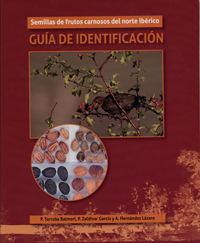FLESHY FRUIT SEEDS FROM THE NORTHERN IBERIAN REGION. IDENTIFICATION GUIDE. (Includes DVD).
Synopsis
PRIZE FOR THE BEST MONOGRAPH IN EXPERIMENTAL SCIENCES AND TECHNOLOGY (2014), AWARDED BY THE UNE (UNION OF SPANISH UNIVERSITY PUBLISHERS).
In the Iberian Peninsula, angiosperm species with fleshy fruits are numerous, but certain gymnosperms also have structures that resemble and function like fleshy fruits, such as the galls of junipers and savins. Why do some plants invest so much effort into producing a fleshy pulp surrounding their seeds? It is accepted that this method is used to attract different species of frugivorous animals, especially birds and mammals, which consume the pulp but disperse the seeds intact through defecation or regurgitation, thus establishing a mutualistic relationship in which both organisms, plant and animal, benefit. This innovative guide describes and visually identifies the seeds of wild and feral fleshy fruits from the northern Iberian Peninsula, many of which are also found in the southern half of the Iberian Peninsula, offering morphometric information on 94 species. In addition to the purely botanical interest of this guide, it is also useful as a tool for determining the seeds found in the excrement and regurgitation of dispersing vertebrates, and as an aid in different lines of research on frugivory and endozoochory. Each plant species is accompanied by a review of the animal species that feed on its fruits.


